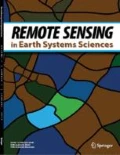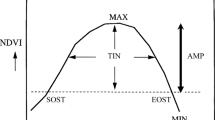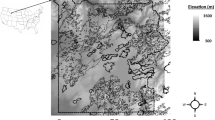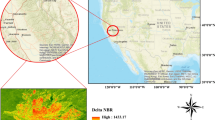Abstract
Trends and geographic patterns of change in vegetation phenology metrics and snowmelt timing from the MODerate resolution Imaging Spectroradiometer (MODIS) satellite data sets were analyzed across the state of Alaska for all wildfires that burned during the years 2004 and 2005. Phenology metric patterns (over the period 2000 to 2018) derived from the normalized difference vegetation index (NDVI) time-series at 250-m resolution tracked changes in the growing season length and integrated greenness cover over the past two decades. NDVI metrics showed that end of the growing season timing (EOST) and integrated greenness increased significantly in the majority of severely burned areas in Interior Alaska over the past decade particularly in low elevation zones below 500 m. In years with relatively early snowmelt dates (3 to 10 days earlier than the long-term mean), lower plant growth was observed over the ensuing growing season, potentially due to lower snow water inputs that can maintain available soil moisture levels for plant growth into the mid- and late-summer months. Statewide trends in MODIS phenology metrics indicate that the predominant vegetation cover type in most regrowing burned areas of Interior Alaska a decade post-fire is still deciduous shrub and young tree cover. Several large fires of special interest were identified to monitor with remote sensing and continue to track long-term recovery patterns and rates.












Similar content being viewed by others
References
Aho KA (2014) Foundational and applied statistics for biologists. Chapman & Hall, CRC Press ISBN 978-1439873380
Amiro BD, Chen JM, Liu J (2000) Net primary productivity following forest fire for Canadian ecoregions. Can J For Res 30:939–947
Campbell J, Wynne R (2011) Introduction to remote sensing. The Guilford Press, p 662
Casady GM, Marsh SE (2010) Broad-scale environmental conditions responsible for post-fire vegetation dynamics. Remote Sens 2:2643–2664
Chu T, Guo X (2014) Remote sensing techniques in monitoring post-fire effects and patterns of forest recovery in boreal forest regions: a review. Remote Sens 6:470–520
Chu T, Guo X, Takeda K (2017) Effects of burn severity and environmental conditions on post-fire regeneration in Siberian larch forest. Forests 8:76. https://doi.org/10.3390/f8030076
Cuevas-Gonzalez M, Gerard F, Balzter H, Riano D (2009) Analysing forest recovery after wildfire disturbance in boreal Siberia using remotely sensed vegetation indices. Glob Chang Biol 15:561–577
Eidenshink J, Schwind B, BrewerK ZZ, Quayle B, Howard S (2007) A project for monitoring trends in burn severity. Fire Ecol 3:3–21
Gillett N, Weaver A, Zwiers F, Flannigan M (2004) Detecting the effect of climate change on Canadian forest fires. Geophys Res Lett 31:L18211. https://doi.org/10.1029/2004GL020876
Greene D, Johnson E (1999) Modelling recruitment of Populus tremuloides, Pinus banksiana, and Picea mariana following fire in the mixed wood boreal forest. Can J For Res 29:462–473
Homer CG, Dewitz JA, Yang L, Jin S, Danielson P, Xian G, Coulston J, Herold ND, Wickham JD, Megown K (2015) Completion of the 2011 National Land Cover Database for the conterminous United States - representing a decade of land cover change information. Photogramm Eng Remote Sens 81:345–354
Huete A, Didan K, Miura T, Rodriquez E, Gao X, Ferreira L (2002) Overview of the radiometric and biophysical performance of the MODIS vegetation indices. Remote Sens Environ 83:195–121
Johnstone J (2005) Effects of aspen (Populus tremuloides) sucker removal on postfire conifer regeneration in central Alaska. Can J For Res 35:483–486
Johnstone J, Kasischke E (2005) Stand-level effects of soil burn severity on postfire regeneration in a recently burned black spruce forest. Can J For Res 35:2151–2163
Johnstone J, Chapin FS III, Foote J, Kemmett S, Price K, Viereck L (2004) Decadal observations of tree regeneration following fire in boreal forests. Can J For Res 34:267–273
Johnstone J, Hollingsworth T, Chapin FS, Mack M (2010) Changes in fire regime break the legacy lock on successional trajectories in Alaskan boreal forest. Glob Chang Biol 16:1281–1295
Kasischke E, Turetsky M (2006) Recent changes in the fire regime across the North American boreal region - spatial and temporal patterns of burning across Canada and Alaska. Geophys Res Lett 33:L09703. https://doi.org/10.1029/2006GL025677
Kasischke E, Bourgeau-Chavez L, Johnstone J (2007) Assessing spatial and temporal variations in surface soil moisture in fire-disturbed black spruce forests in interior Alaska using spaceborne synthetic aperture radar imagery - implications for post-fire tree recruitment. Remote Sens Environ 108:42–58
Kautz, D. 2004. Land resource regions and major land resource areas of Alaska, United States Department of Agriculture, Natural Resources Conservation Service, Available online at: http://www.ak.nrcs.usda.gov/technical/lrr.html
Li S, Potter CS (2012) Vegetation regrowth trends in post forest fire ecosystems across North America from 2000 to 2010. Nat Sci 4. https://doi.org/10.4236/ns.2012
LP-DACC: NASA Land Processes Distributed Active Archive Center. 2007. MODIS/Terra Vegetation Indices Monthly L3 Global 0.05Deg CMG (MOD13C2), Version 005. Sioux Falls, South Dakota: USGS/Earth Resource s Observation and Science (EROS) Center
Meier G, Brown J, Evelsizer R, Vogelmann J (2015) Phenology and climate relationships in aspen (Populus tremuloides Michx.) forest and woodland communities of southwestern Colorado. Ecol Indic 48:189–197
Natural Resources Conservation Service (NRCS). 2016. SNOTEL Data & Products, National Water and Climate Center, Available online: http://www.wcc.nrcs.usda.gov/snow/. Accessed May 2018
O'Leary D III, Bloom T, Smith J, Zemp C, Medler M (2016) A new method comparing snowmelt timing with annual area burned. Fire Ecol 12. https://doi.org/10.4996/fireecology.1201041
O'Leary III, D., D.K. Hall, M. Medler, R. Matthews, and A. Flower. 2017. Snowmelt timing maps derived from MODIS for North America, 2001-2015. ORNL DAAC, Oak Ridge, Tennessee, USA https://doi.org/10.3334/ORNLDAAC/1504, Accessed May 2019
Olsen J, Miehe S, Ceccato P, Fensholt R (2015) Does EO NDVI seasonal metrics capture variations in species composition and biomass due to grazing in semi-arid grassland savannas? Biogeosciences 12:4407–4419
Potter C (2018) Recovery rates of wetland vegetation greenness in severely burned ecosystems of Alaska derived from satellite image analysis. Remote Sens 10:1456
Potter C (2019) Changes in vegetation cover of the Arctic National Wildlife Refuge estimated from MODIS greenness trends. Earth Interact 23:1–18
Potter CS, Brooks V (1998) Global analysis of empirical relations between annual climate and seasonality of NDVI. Int J Remote Sens 19:2921–2948
Potter C, Dolanc C (2016) Thirty years of change in subalpine forest cover from Landsat image analysis in the Sierra Nevada Mountains of California. For Sci 62:623–632
Randerson J, Liu H, Flanner F et al (2006) The impact of boreal forest fire on climate warming. Science 314:1130–1132
Reed B., M. Budde, P. Spencer, and A. Miller. 2006. Satellite-derived measures of landscape processes: draft monitoring protocol for the Southwest Alaska I&M network, ver. 1.0. National Park Service, Inventory & Monitoring Program, Southwest Alaska Network, Anchorage, Alaska. 30 pp.
Seaber, P. R., F. P. Kapinos, and G. L. Knapp, 1987. Hydrologic Unit Maps: U.S. Geological Survey Water-Supply Paper 2294, 63 p
Selkowitz D, Stehman S (2011) Thematic accuracy of the National Land Cover Database (NLCD) 2001 land cover for Alaska. Remote Sens Environ 115:1401–1407
Shao Y, Lunetta RS, Wheeler B, Iiames JS, Campbell JB (2016) An evaluation of time-series smoothing algorithms for land-cover classifications using MODIS NDVI multi-temporal data. Remote Sens Environ 174:258–265
Verbesselt J, Hyndman R, Newnham G, Culvenor D (2010a) Detecting trend and seasonal changes in satellite image time series. Remote Sens Environ 114:106–115
Verbesselt J, Hyndman R, Zeileis A, Culvenor D (2010b) Phenological change detection while accounting for abrupt and gradual trends in satellite image time series. Remote Sens Environ 114:2970–2980
Wang J, Rich P, Price K, Kettle W (2005) Relations between NDVI, grassland production, and crop yield in the central Great Plains. Geocarto Int 20:5–11
Zhu, J., A. Miller, C. Lindsay, D. Broderson, T. Heinrichs, and P. Martyn, 2013, MODIS NDVI products and metrics user manual, version 1.0, geographic information network of Alaska, University of Alaska, Fairbanks, 18 pp. Available online at http://static.gina.alaska.eud
Zyryanova, O., A. Abaimov, T. Bugaenko, and N. Bugaenko, 2010, Recovery of forest vegetation after fire disturbance. In Permafrost ecosystems, Springer: Berlin/Heidelberg, Germany, pp. 83–96
Acknowledgments
This work was supported by NASA Ames Research Center, as a contribution to NASA ABoVE (Arctic Boreal Vulnerability Experiment) project.
Author information
Authors and Affiliations
Corresponding author
Additional information
Publisher’s Note
Springer Nature remains neutral with regard to jurisdictional claims in published maps and institutional affiliations.
Rights and permissions
About this article
Cite this article
Potter, C. Changes in Growing Season Phenology Following Wildfires in Alaska. Remote Sens Earth Syst Sci 3, 95–109 (2020). https://doi.org/10.1007/s41976-020-00038-7
Received:
Revised:
Accepted:
Published:
Issue Date:
DOI: https://doi.org/10.1007/s41976-020-00038-7




